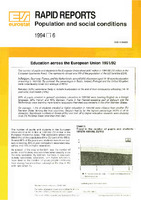Rapid Reports Population and social conditions. Education across the European Union 1991/92. 1994.6

working document
Author
Eurostat
Date
1994View/
Subject headings
Social ConditionsAbstract
The number of pupils and students in the European Union stood at 67 million in 1991/92 (72 million in the European Economic Area). This represents almost one fifth of the population of the EU (and the EEA). In Belgium, Germany, France, and the Netherlands, around 90% of persons aged 1618 were in education or training in 1991/92. By contrast, the percentages in Spain, Ireland, Portugal and the United Kingdom were considerably lower (EU average of 80%). Females (82%) were more likely to remain in education at the end of their compulsory schooling (1618 year olds) than males (78%). 83% of pupils enrolled in general secondary education in 1991/92 were learning English as a foreign language, 32% French and 16% German. Pupils in the Flemishspeaking part of Belgium and the Netherlands were learning more foreion languages than their counterparts in the other Member States. On average, 1.3% of students enrolled in higher education in 1991/92 were citizens from another EU Member State. Among the host countries, Belgium had by far the highest percentage (4.8% of all its students). Significant numbers of Greek (10%) and Irish (6%) higher education students were studying in an EU Member State other than their own.
